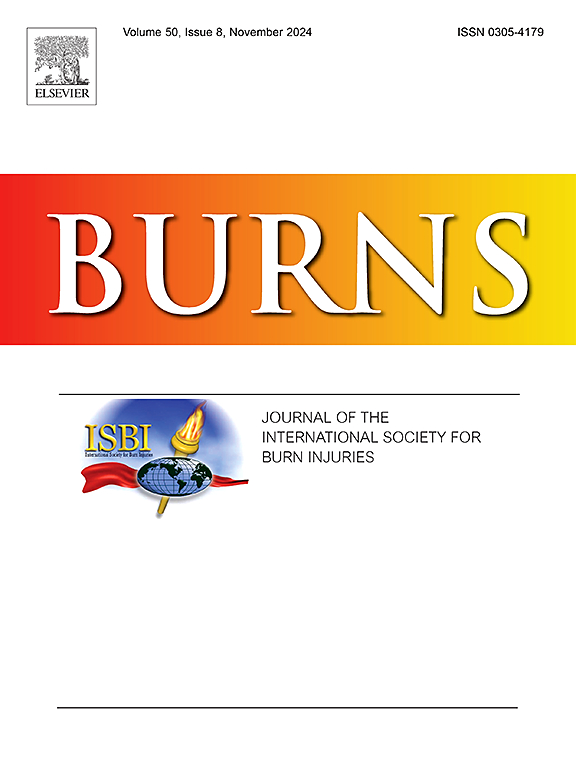The effectiveness of tumescent anesthesia in managing pain for enzymatic debridement of burns. A case-control study
IF 3.2
3区 医学
Q2 CRITICAL CARE MEDICINE
引用次数: 0
Abstract
Introduction
Burn injuries are a global health challenge, causing significant pain, tissue damage and complex wound management issues. Traditional treatments like surgical debridement, while effective, pose challenges such as blood loss, grafting requirements, and prolonged hospital stays. Enzymatic debridement, such as the Nexobrid procedure, effectively removes necrotic tissue but can be painful for patients. This study evaluates the efficacy of tumescent anesthesia with lidocaine (TLA) in managing pain during this procedure.
Methods
This retrospective case-control clinical study was conducted at Cannizzaro Hospital in Catania from January 2023 to January 2024. It included 23 patients aged ≥ 18 years with thermal burns on the trunk or multiple locations, who did not require mechanical ventilation due to other causes. The case group (TLA group) included 10 patients treated with tumescent anesthesia (TLA), while the control group (w/o TLA) included 13 patients managed with standard general/opioid methods. Pain was assessed using the Numeric Pain Scale (NPS) at multiple time points.
Results
Descriptive statistics were calculated for age, TBSA, and pain values measured with the NRS scale for each time interval. In the TLA group, the Friedman One-Way Repeated Measures ANOVA revealed a statistically significant reduction in perceived pain over time (p < 0.001), which was not observed in the control group(p = 0.121). The Mann-Whitney U test indicated a statistically significant difference in pain between the two groups (p < 0.05), with lower pain levels in the TLA group.
Conclusion
TLA effectively manages pain in burn patients undergoing enzymatic debridement.This approach improves patient outcomes and satisfaction by providing effective pain control, minimizing recovery time, and offering a viable alternative to traditional anesthesia methods. Further research with larger, multi-center studies is recommended to validate these findings and establish standardized protocols for TLA in burn care.
肿胀麻醉对烧伤酶清创术后疼痛的控制效果。病例对照研究。
烧伤是一个全球性的健康挑战,造成严重的疼痛、组织损伤和复杂的伤口管理问题。手术清创等传统治疗方法虽然有效,但也带来了诸如失血、移植要求和住院时间延长等挑战。酶清创,如Nexobrid程序,可以有效地去除坏死组织,但对患者来说可能是痛苦的。本研究评估利多卡因肿胀麻醉(TLA)在此过程中控制疼痛的效果。方法:于2023年1月至2024年1月在卡塔尼亚Cannizzaro医院进行回顾性病例对照临床研究。纳入23例年龄≥ 18岁,躯干或多部位热烧伤,因其他原因不需要机械通气的患者。病例组(TLA组)包括10例接受肿胀麻醉(TLA)治疗的患者,对照组(无TLA)包括13例采用标准的一般/阿片类药物方法治疗的患者。在多个时间点使用数值疼痛量表(NPS)评估疼痛。结果:用NRS量表对各时间间隔的年龄、TBSA和疼痛值进行描述性统计。在TLA组中,Friedman单向重复测量方差分析显示,随着时间的推移,感知疼痛的减少具有统计学意义(p )。结论:TLA有效地控制了接受酶清创的烧伤患者的疼痛。这种方法通过提供有效的疼痛控制,最大限度地减少恢复时间,并提供传统麻醉方法的可行替代方案,提高了患者的预后和满意度。建议进行更大规模、多中心的进一步研究,以验证这些发现,并建立烧伤护理中TLA的标准化方案。
本文章由计算机程序翻译,如有差异,请以英文原文为准。
求助全文
约1分钟内获得全文
求助全文
来源期刊

Burns
医学-皮肤病学
CiteScore
4.50
自引率
18.50%
发文量
304
审稿时长
72 days
期刊介绍:
Burns aims to foster the exchange of information among all engaged in preventing and treating the effects of burns. The journal focuses on clinical, scientific and social aspects of these injuries and covers the prevention of the injury, the epidemiology of such injuries and all aspects of treatment including development of new techniques and technologies and verification of existing ones. Regular features include clinical and scientific papers, state of the art reviews and descriptions of burn-care in practice.
Topics covered by Burns include: the effects of smoke on man and animals, their tissues and cells; the responses to and treatment of patients and animals with chemical injuries to the skin; the biological and clinical effects of cold injuries; surgical techniques which are, or may be relevant to the treatment of burned patients during the acute or reconstructive phase following injury; well controlled laboratory studies of the effectiveness of anti-microbial agents on infection and new materials on scarring and healing; inflammatory responses to injury, effectiveness of related agents and other compounds used to modify the physiological and cellular responses to the injury; experimental studies of burns and the outcome of burn wound healing; regenerative medicine concerning the skin.
 求助内容:
求助内容: 应助结果提醒方式:
应助结果提醒方式:


